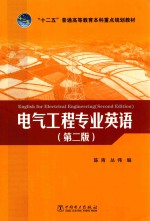图书介绍
电气工程专业英语pdf电子书版本下载

- 陈青,丛伟编;胡钋主审 著
- 出版社: 北京:中国电力出版社
- ISBN:9787512373495
- 出版时间:2015
- 标注页数:243页
- 文件大小:42MB
- 文件页数:253页
- 主题词:电气工程-英语-高等学校-教材
PDF下载
下载说明
电气工程专业英语PDF格式电子书版下载
下载的文件为RAR压缩包。需要使用解压软件进行解压得到PDF格式图书。建议使用BT下载工具Free Download Manager进行下载,简称FDM(免费,没有广告,支持多平台)。本站资源全部打包为BT种子。所以需要使用专业的BT下载软件进行下载。如 BitComet qBittorrent uTorrent等BT下载工具。迅雷目前由于本站不是热门资源。不推荐使用!后期资源热门了。安装了迅雷也可以迅雷进行下载!
(文件页数 要大于 标注页数,上中下等多册电子书除外)
注意:本站所有压缩包均有解压码: 点击下载压缩包解压工具
图书目录
Unit 1 Electrical Machines 1
1.1 Alternating-Current Machines 1
1.1.1 General 1
1.1.2 Synchronous Generator Principle and Construction Features 2
1.1.3 Synchronous Generator Performance 4
1.1.4 Synchronous Motors 6
1.2 Synchronous Machine Theory and Modeling 8
1.2.1 Physical Description 8
1.2.2 Mathematical Description of a Synchronous Machine 13
1.2.3 Basic Equations of a Synchronous Machine 17
1.2.4 The dq0 Transformation 22
1.3 Induction Motor 26
1.3.1 A General Outline of Induction Machines 26
1.3.2 Induction Motor Action 28
1.3.3 Construction Features of an Induction Motor 30
1.3.4 Running Conditions of an Induction Motor 32
1.4 Transformer 33
1.4.1 Single-phase Transformer Model 33
1.4.2 Equivalent Circuits for Practical Transformers 38
1.4.3 Three-Phase Transformer Connections 41
1.4.4 Per Unit Normalization 45
Unit 2 Electric Power System 49
2.1 Introduction 49
2.1.1 Evolution of Electric Power Systems 49
2.1.2 Present and Future Trends of Power Systems 51
2.1.3 Structure of the Power System 53
2.1.4 Power System Control 56
2.1.5 Introduction to EHV AC Transmission 59
2.2 Electric Power System Operation 61
2.2.1 Power System Planning 61
2.2.2 Power System Load 63
2.2.3 Reactive Power 65
2.2.4 Power System Monitoring 66
2.2.5 Economic Dispatching 68
2.3 Power System Stability Problem 71
2.3.1 Basic Concepts and Definitions 71
2.3.2 Rotor Angle Stability 72
2.3.3 The Stability Phenomena 74
2.3.4 Mid-Term and Long-Term Stability 75
2.3.5 Origin of Overvoltages and Their Types 77
2.4 Fault and Relaying Protection 78
2.4.1 Faults in Power System 78
2.4.2 Role of Protection in a Power System 80
2.4.3 Some Components of Protection 82
2.4.4 Fundamental Protection Principles 84
2.5 High Voltage Direct Current(HVDC)Transmission Systems Technology Review Paper 86
2.5.1 Introduction to HVDC 86
2.5.2 Advances in Technology and the Roles of HVDC 90
2.5.3 Design,Operation,Maintenance and Cost Considerations 94
2.5.4 HVDC Applications 99
Unit 3 Distributed Power Generation 103
3.1 Distributed Generation Versus Traditional Power Systems 103
3.1.1 Distributed Versus Central Station Generation 103
3.1.2 Other Advantages and Disadvantages of DG 105
3.1.3 Power “from the Grid” as a Target for DG 106
3.2 Renewable Resource Distributed Generators 108
3.2.1 Introduction 108
3.2.2 Solar Thermal Power Generation 109
3.2.3 Photovoltaic(PV) Generation 111
3.2.4 Wind-Powered Generation 113
3.2.5 Other Renewable Generation Resources 116
3.3 Energy Storage for Use with Distributed Generation 119
3.3.1 Chemical,Electrical,or Physical Storage Systems for Electrical Energy 119
3.3.2 Battery Storage 120
3.3.3 Superconducting Magnetic Energy Storage(SMES) 122
3.3.4 Capacitor Storage 125
3.3.5 Mechanical Storage:Flywheels 127
3.4 Micro Grid 130
3.4.1 The Concept and Structure of Micro Grid 130
3.4.2 The Critical Functions of Micro Grid 132
3.4.3 Control Methods of Micro Grid 133
Unit 4 Smart Grid 136
4.1 Introduction of the Smart Grid 136
4.1.1 Introduction of the Background 136
4.1.2 Why implement the Smart Grid now 137
4.1.3 What the Smart Grid is and Overview of the Technologies Required for the Smart Grid 139
4.2 Flexible AC Transmission Systems 142
4.2.1 Opportunities for FACTS 142
4.2.2 Basic Types of FACTS Controllers 145
4.2.3 Description and Definitions of FACTS Controllers-shunt Connected Controllers 149
4.2.4 Basic Description and Definitions of FACTS Controllers-series Connected 153
4.2.5 Possible Benefits from FACTS Technology 157
4.3 Wide Area Measurement and Control System 162
4.3.1 Phasor Measurement Units(PMU) 162
4.3.2 Wide Area Measurement and Its Application 165
4.3.3 Wide Area Control System 167
4.3.4 Wide Area Protection Systems 171
4.4 Vision for smart grid development to 2050 176
4.4.1 Influencing Factors for Development of Smart Grids and the Impact of Smart Grids for the Peak Demand 176
4.4.2 Regional Scenarios for Deployment to 2050 178
4.4.3 Environmental and Economic Effects of Smart Grids 180
Unit 5 Smart Substations 182
5.1 Introduction of Smart Substations 182
5.1.1 Introduction 182
5.1.2 Intelligent Primary Equipments 184
5.1.3 Intelligent Electronic Devices 187
5.2 Smart Distribution Applications 189
5.2.1 Advanced Distribution Management 189
5.2.2 Distribution Automation 192
5.3 The 21 st Century Substation Design:Vision of the Future 194
5.3.1 Introduction 194
5.3.2 Vision of the Substation Design 198
Unit 6 Electric Vehicles 202
6.1 Introduction 202
6.1.1 Introduction of the EV 202
6.1.2 History and Brands of the EV 203
6.2 Vehicle Types 205
6.2.1 Plug-in Electric Vehicle(PEV) 205
6.2.2 Hybrid Electric Vehicle 207
6.2.3 Other Types 208
6.3 Advantages and Disadvantages of EVs 209
6.3.1 Environment and Mechanical Field 209
6.3.2 Energy Field 210
6.4 EV Battery Charging 212
6.4.1 Introduction 212
6.4.2 Charging Technology 213
6.4.3 The Fast Charging 214
Unit 7专业英语的阅读、翻译与写作 217
7.1 专业英语的特点 217
7.2 专业英语中的常用句型 219
7.3 专业英语的翻译 226
7.3.1 被动语态的译法 226
7.3.2 倍数、分数和百分数的译法 227
7.3.3 定语从句的译法 227
7.3.4 名词性从句的译法 228
7.3.5 状语从句的译法 229
7.4 专业英语的写作 229
7.4.1 学术论文写作 229
7.4.2 简历 233
7.4.3 商务信函 234
7.4.4 产品技术说明书 236
常用专业词汇 237
参考文献 243